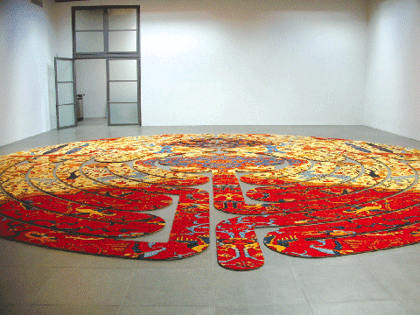Su-Mei Tse’s jarring and provocative juxtapositions
Su-Mei Tse pairs two rich and ancient traditions in “Proposition de détour,” a serene installation at Peter Blum Gallery in Chelsea. A labyrinth patterned after the one in Chartres Cathedral and cut out of a colorful Persian carpet occupies the main gallery space’s floor.
The work can be appreciated simply on an experiential level. Visitors (in socks) can walk the labyrinth seeking an imaginative Minotaur trapped in the center, per Greek mythology. Or they can trace the path to God, as Christians did in medieval times and continue to do today—witness the gentle troughs eroded into Chartres’ marble-slab labyrinth. Or, as contemporary spiritualists do, they can hope to attain enlightenment and self-revelation through a highly focused allegorical sojourn.
Yet even as you undergo one of these journeys, the plush wool carpet, to the modern sole, feels luxurious—more Manhattan penthouse than medieval stone cathedral. The jewel-toned hues of the fibers signify a visual opulence at odds with a spartan spiritual journey. A variety of fauna are depicted, either eating or lounging amidst blooming foliage. Persian carpets can be a compendium of a region’s creatures and plants, but around this context—crisply cut into the shape of a medieval Christian icon—loom ominous undertones of conquering and colonialism.
Tse, Euro-Asian, was born in Luxembourg and trained as a classical cellist. Her heritage and upbringing may help to explain the jarring yet provocative juxtaposition of imagery spanning Asia and Europe. A musical composition, when played properly, unfolds in real time—in a way, tracing a path. Pieces of music take shape in several unique but related sections, which repeat later on, somewhat like the path of a labyrinth doubling back to parallel a previously trod segment. Technology allows us to shortcut full-length pieces, like stepping off a labyrinth’s path, but the fullness of the experience is foiled.
Outdoor labyrinths are often formed of planted hedges or crops. The pathways are devoid of flora—they are represented by negative space, the absence of material. Tse’s labyrinth places this textural, kaleidoscopic, lavish surface along the path, subverting negative space with something very tangible and prominent.
On view in the back gallery are additional smaller works by Tse—who won the Golden Lion at the 2003 Venice Biennale—featuring poetic but disturbing imagery replete with possibility stunted. Splinted fingers attempt to play piano; conch shells embedded in acrylic replace earpieces from a pair of headphones. Tse’s deft sensibility slyly puts an elegant sheen on material that is potentially disturbing or rife with dissent.
gaycitynews.com

































